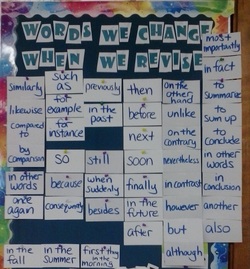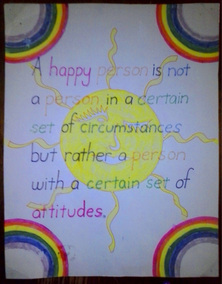
Here are the transition words we've used during our Morning Meeting activity this month.
You've learned to add these words to your ideas and combine sentences so they way they go together is clearer.
Different transition words are used for different types of information. You might need a transition word to show:
1. How things are the same
2. How things are different
3. The order in which things happened
4. That one thing made another thing happen
5. A summary of several details
Can you give an example of which word goes with which type? Here's an example:
In conclusion is used for a summary of several details.

When you do your Reading MCAS practice homework, be sure to ANSWER the question with the steps you've learned in class!
If you are following the steps but you are still not sure what the answer to the question is, you should:
1. Reread the question
2. Reread the selection
3. Think
4. Repeat!

This sign is hanging on our classroom door.
Which scenario demonstrates a positive attitude about the same situation?
We are playing Sparkle.
1. We are spelling "gratitude," and after Kim says "e," Kevin is supposed to say, "sparkle" and is out. He folds his arm, sulks, and yells, "It's not FAIR!" He stomps off and almost steps on Karen's hand as he leaves the rug area.
2. We are spelling "serenity," and after Keri says "y," Kristie is supposed to say, "sparkle," and is out. She shrugs, leaves the circle, gets her snack, thinks, "yay, chocolate chip cookies, my favorite" and checks over her Morning Work to make sure it's complete.

Half of your animals have been captured and put into the zoo. Their twins are still located around the classroom though.

Here's a real life example of camouflage. At recess there was a hawk in one of the trees. Can you find it?

We have been working on our responses to reading, also known as the MCAS Open Response. Each week we review the ANSWER method to answering these questions completely, and you each set a goal to increase your score by including one more detail than the week before.
Our class's goal is to help each other so that no one has fewer than 3 correct detail sentences.
Currently (after correcting Storms) there are only 6 students who are still scoring under 3.
Do you have any advice for those kids who only need one

Summaries are useful for quickly learning what a longer text is about, since they are much shorter.
When you write a summary of a nonfiction article, use the text features to help you. Write the main idea of the whole article in once sentence. Often the title will help you with that.
Then, see if the headings will help you take notes. If they don't, read the first and last sentence of each paragraph to find the topic of each paragraph. Write the topics in note form.
Finally, write sentences using the words in a way that makes sense. Think about what the author wanted you to know about each topic to form main idea sentences.
Think about Diggin Dirt. Of course the topic is dirt. What is the author mostly teaching you about dirt?

Remember, the topic is one or two words. The main idea is a complete sentence that tells about the topic.
Can you match one of the following topics to the main idea?
a. Birds
b. Landforms
c. Problem Solving
1. The Northeast Region has several different types of landforms.
2. You can solve some math problems using bar models.
3. Birds have several characterstics that are unique to

For 30 days, we added 10 centimeter grids to our length visual. Now we have 30 10 centimeter grids.
If you look at the yellow and green section, you'll see it has 10 of the 10 cm grids. 10x10=100, and 100 cm equals 1 meter.
How many meters are there altogether?












 RSS Feed
RSS Feed